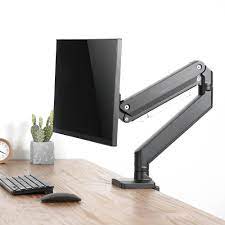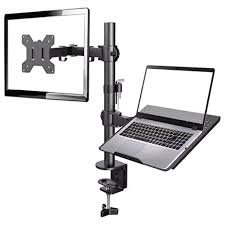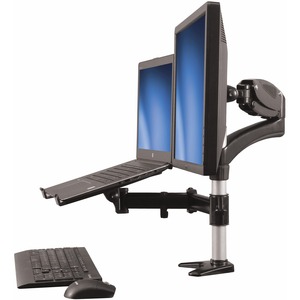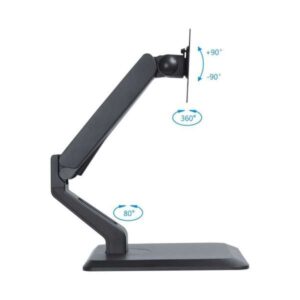

Forward head posture is one of the most common modern-day issues that plague people who spend long hours at desks, working on computers, or staring at screens.
This condition, where the head juts forward beyond its natural alignment, causes neck strain, back pain, and poor posture.
But can something as simple as a monitor stand be the solution?
Let me discuss the role a monitor stand plays in fixing forward head posture and see whether this adjustment can really help.
Can a Monitor Stand Fix Your Forward Head Posture Article Index
- What is Forward Head Posture?
- The Role of Screen Height in Posture
- How Does a Monitor Stand Help?
- Exploring Different Types of Monitor Stands
- Monitor Stand
- Dual Monitor Stand
- Monitor Stand for Dual Monitors
- Monitor Riser
- PC Monitor Mount and Arm: Do They Help?
- The Science Behind Monitor Stands and Posture
- Conclusion: Can a Monitor Stand Fix Your Forward Head Posture?
What is Forward Head Posture?
Forward head posture (FHP) occurs when your head moves forward, pulling your neck and shoulders out of alignment. Ideally, your head should sit directly over your shoulders, maintaining a straight line from the top of your spine.
FHP, however, disrupts this natural alignment, causing the neck and upper back muscles to strain. This condition is exacerbated by poor ergonomics, especially when using a computer for long periods.
So, could adjusting the height of your laptop monitor provide relief?
The Role of Screen Height in Posture
One of the leading causes of forward head posture is improper screen height.
If your monitor is too low, you instinctively lean forward to get a better view, which gradually pushes your head out of alignment. Over time, this can lead to chronic neck pain, headaches, and tension in the upper back and shoulders.
According to a study published in the Journal of Physical Therapy Science, adjusting screen height is a key factor in improving ergonomic conditions and reducing FHP.
By elevating the screen to eye level, you maintain a neutral head position, which helps relieve the strain on the muscles and joints in your neck and upper back.
This is where the monitor stand comes into play.
How Does a Monitor Stand Help?
Ensuring your computer monitor is positioned correctly is essential for maintaining good posture and reducing the risk of discomfort or injury.
Here are some practical and easy-to-follow tips to help you set up your monitor ergonomically:
1. Adjust Monitor Height:
Position the top of your screen at or slightly below eye level. This setup encourages a neutral head position, reducing strain on your neck and shoulders. According to the Mayo Clinic, improper monitor height is a leading cause of neck and upper back pain among office workers.
2. Maintain Proper Distance:
Your monitor should be about an arm’s length away, typically between 20 to 40 inches from your eyes. This distance helps prevent eye strain and allows you to view the entire screen comfortably.
The Mayo Clinic emphasizes that positioning your screen too close or too far can lead to visual discomfort and headaches.
3. Consider Screen Tilt:
Tilting your monitor slightly backward—about 10 to 20 degrees—can help reduce glare and promote a more natural viewing position.
Experts at UpDown Desk recommend this angle to improve screen visibility and minimize unnecessary head movement.
4. Utilize Monitor Stands or Arms:
If your monitor’s height is not adjustable, a monitor stand or an adjustable arm can help.
These accessories allow you to customize the monitor’s position to fit your ergonomic needs, ensuring comfort during extended use.
According to Wikipedia, using a monitor mount can significantly improve desk ergonomics by reducing strain on the neck and shoulders.
5. Optimize Dual Monitor Setups:
For those using two monitors, place the primary screen directly in front of you and the secondary one to the side.
Ensure both monitors are at the same height and distance to minimize neck and eye strain.
Research from CMD Ltd highlights that an ergonomic dual monitor setup can improve productivity and reduce discomfort associated with prolonged screen use.
6. Incorporate Regular Breaks:
Even with an optimal setup, taking regular breaks is crucial. Stand, stretch, and look away from the screen periodically to reduce fatigue and improve circulation.
The Mayo Clinic suggests following the 20-20-20 rule: every 20 minutes, look at something 20 feet away for at least 20 seconds to prevent eye strain.
By following these guidelines, you can create a more comfortable and ergonomic workspace that enhances productivity and overall well-being.
Proper monitor positioning not only helps with posture but also plays a vital role in reducing common work-related discomforts.
Exploring Different Types of Monitor Stands
Not all monitor stands are created equal. Depending on your workspace and setup, there are various options available. Let’s break down the key types:
Monitor Stand
A basic monitor stand is a small platform that raises your monitor to eye level. It is ideal for single monitor setups and comes in various designs, including adjustable models that allow you to customize the height.
Dual Monitor Stand
A dual monitor stand allows users to elevate two monitors simultaneously. This is especially useful for people who work with multiple screens, such as designers, video editors, or programmers.
With a dual computer monitor stand, you can ensure both screens are aligned at the proper height, helping to maintain good posture.
Monitor Stand for Dual Monitors
Similar to a dual monitor stand, a monitor stand for dual monitors is designed for workstations that use two screens.
These stands often come with customizable height and tilt options, ensuring you maintain an ergonomic posture even when shifting between screens.
Monitor Riser
A monitor riser is another popular solution for adjusting screen height. It’s typically a simple, sleek stand that raises your monitor to the correct position.
Some risers also offer storage space underneath, helping keep your desk clutter-free.
Research shows that using a monitor riser can significantly reduce neck strain and improve overall posture (source: Workplace Health & Safety).
PC Monitor Mount and Arm: Do They Help?
A PC monitor arm or PC monitor mount provides even more flexibility than a traditional monitor stand.
These mounts are attached to the back of your desk or wall and allow you to adjust the height, angle, and distance of your monitor.
This setup is particularly beneficial for those who prefer to switch between sitting and standing while working.
One study from Applied Ergonomics highlighted that workers who used adjustable pc monitor mounts reported lower levels of discomfort in the neck and shoulders.
The ability to move your screen according to your sitting or standing position promotes better spinal alignment and reduces the risk of forward head posture.
The Science Behind Monitor Stands and Posture
Scientific evidence supports the use of ergonomic tools like monitor stands to improve posture.
According to a 2019 study in the Journal of Chiropractic Medicine, participants who adjusted their monitor height using a monitor riser experienced less neck pain and showed a marked improvement in overall posture.
The study demonstrated that small changes, like elevating the monitor to eye level, can have a significant impact on reducing FHP.
Further research from Human Factors and Ergonomics in Manufacturing & Service Industries found that individuals using ergonomic monitor stands were less likely to experience chronic neck issues compared to those using improperly positioned monitors.
The combination of ergonomic workstations and regular posture exercises can lead to long-term improvements in neck and back health, making tools like monitor stands an essential part of modern workplace ergonomics.
Conclusion: Can a Monitor Stand Fix Your Forward Head Posture?
So, can a monitor stand fix your forward head posture? The answer is yes—when used correctly, a monitor stand can significantly improve your posture and reduce the symptoms associated with forward head posture.
By raising your monitor to eye level, you encourage a neutral head and neck position, which takes the strain off your cervical spine and upper back muscles.
However, it’s important to note that a monitor stand alone is not a complete solution. Regular posture checks, ergonomic chair adjustments, and movement breaks are also key to preventing forward head posture.
Combine these with a monitor stand, and you’re well on your way to a healthier, pain-free work experience.
In short, whether you’re using a dual monitor stand, a monitor stand for dual monitors, or a PC monitor arm, the key to better posture is in the details.
By making small, ergonomic changes, you can drastically improve your workday and your long-term health.
References:


